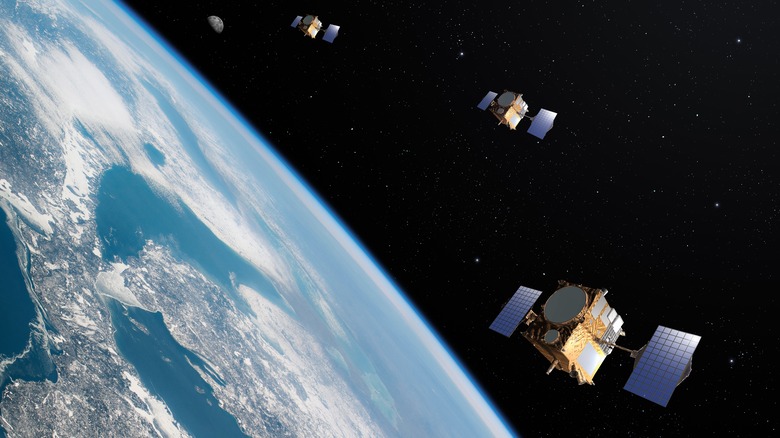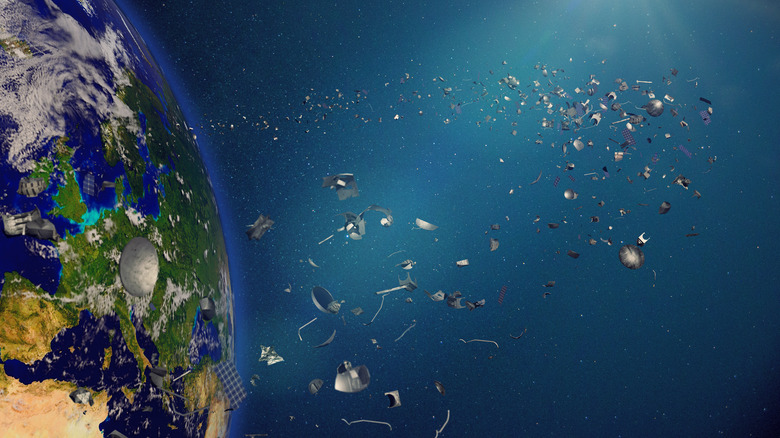You Should Be Worried For The Future Of Satellites - Here's Why
How many satellites and other objects are currently zipping around Earth? It should be an easy question to answer, yet no one can seem to agree on how many are up there because the rate at which we're sending them into orbit has increased so dramatically in recent years.
According to the Union of Concerned Scientists (UCS), as of May 1, 2022, there are 5,465 satellites currently floating around Earth's orbit. A January 2022 report from DEWESoft states there were 4,550 satellites in orbit, a number supposedly compiled by information from the UCS Satellite Database, Environmental Systems Research Institute (ESRI), and the Space Foundation. If you check a February 2022 report from Surveying Group News, there are supposedly 4,852 operational satellites in orbit (as of January 1, 2022). But wait, it gets even more confusing.
Did you know that the United Nations has an Office for Outer Space Affairs (UNOOSA)? That office manages the "Online Index of Objects Launched into Outer Space." It tracks all objects — not just your typical telecommunications data satellites — that have launched into space since 1958, many of which have broken up and plummeted back to Earth as fragments, or burnt up entirely in the atmosphere.
Without filtering, UNOOSA's index reports that 14,098 objects (at the time of writing) have been launched into space. But if you filter down by those "in orbit," it drops to 9,918. However, you get an entirely different number — 8,556 — if you filter by "status" and then by "in orbit." And that's just for satellites that are part of public record.
A sky filled with man-made stars
Given that, we can only assume a total of somewhere between 4,500 satellites to as many as 10,000 are currently circling the third rock from the Sun. The United States has most of them; with USC reporting 3,433 satellites and UNOOSA listing 5,544 U.S.-made objects in orbit.
One of the index filters allows you to parse data via "Launch Year," which tells how many objects were launched annually from 1958 through 2022. On October 4, 1957, the Soviet Union launched the first manufactured object known as Sputnik 1 into low Earth orbit (LEO). They sent a second Sputnik device up that same year, and a third in 1958 — the same year the U.S. sent up its first objects, Explorer 1 (in January) and then Vanguard 1 (in March). Vanguard 1 was the fourth artificial object in space and is the oldest "satellite" still in orbit. It's also the first object listed on UNOOSA's index.
According to UNOOSA, Between 2000 and 2016, the U.S. never launched more than 56 satellites in any given year, and averaged about 30 per year. That number more than tripled in 2017 when 193 satellites went up, followed by 165 the next year, and 154 more in 2019. But then things really took a hyperspace jump in 2020, as an astonishing 840 more satellites were put into space, followed by 1,166 in 2021. And in 2022, at the time of this writing, 1,618 satellites have been shot spaceward.
No one wants to catch Kessler syndrome
Elon Musk has a lot to do with the pronounced increase, as he plans to have 42,000 Starlink satellites buzzing around low Earth orbit (LEO) to provide high-speed, low-latency internet to the entire world. On October 20, 2022, SpaceX made its 63rd dedicated Starlink launch, bringing the total number of Starlinks launched to 3,505 satellites as of this writing. Of those, 275 have returned to Earth, and 63 aren't functioning, leaving 2,704 working Starlink satellites in orbit.
But Starlink isn't the only one clogging up the space lanes. Massive technology companies like Amazon, Boeing, Inmarsat, Intelsat, Hughes Network, OneWeb, Telesat, and others have been bombarding the Federal Communications Commission to approve over 100,000 additional satellite launches. An incredible 38,000 were proposed solely in November of 2021.
This is where we drop out of lightspeed to Kessler. Donald Kessler was NASA's Senior Scientist for Orbital Debris Research until he retired in 1996. He has 40 years of expertise in "orbital debris, meteoroids, and interplanetary dust." In 1978, he and co-author Burton Cour-Palais published a paper called "Collision Frequency of Artificial Satellites: The Creation of a Debris Belt." They theorized that as more artificial objects went into orbit, the higher the chances they would collide. In turn, this would create a snowball effect culminating in a cascading cloud of debris that would hit even more objects until a permanent debris belt surrounded the Earth.
The idea has since become known as the "Kessler syndrome." Scientists now fear we are reaching that threshold.
We can't just make the junk disappear
Federal organizations around the world are in charge of tracking the approximate amount of debris is orbiting Earth's atmosphere. The Department of Defense's Space Surveillance Network tracks objects as small as two inches, and the European Space Agency (ESA) keeps tabs on space debris as well. According to their latest numbers (as of November 7, 2022), there are 32,120 "debris objects" in LEO, with another 630 estimated "break-ups, explosions, collisions, and anomalous events resulting in fragmentation." The total mass of space junk in LEO is estimated to be over 22,928,075 pounds (or 10,400 metric tons).
As a result, according to NASA, various impacts and accidents have continued to compound the space junk problem — and even threatened lives. Between 1999 and 2021, the International Space Station (ISS) had to make avoidance maneuvers around space junk 29 separate times to steer clear of danger. Another maneuver was performed as recently as November 2021.
With thousands of satellites now in orbit, and some 100,000 more ready to be launched, it's only a matter of time before Kessler's syndrome becomes a reality. For obvious reasons, a scenario like this would impair our ability to launch additional satellites, not to mention endanger the International Space Station and its crew. It might even put a kibosh on future space missions to the Moon, Mars, and beyond. Even looking through a telescope into the heavens could become problematic as space junk accumulation increases.


